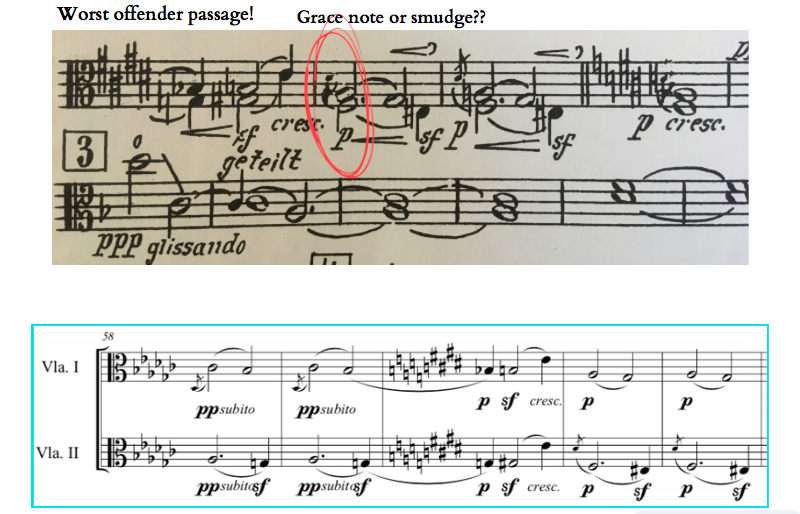This chorale setting seems to be popular for Good Friday services, with the cello playing the chorale tune. I got asked to play this for a Good Friday service, and although it is slow and I could read the part in bass clef, I don’t want to have to think that hard. Therefore, I had this part made with the tune written in alto clef. If you are playing this piece, I hope you find this part helpful.
Britten: Four Sea Interludes from the opera Peter Grimes
Candidate #4: I. Dawn
Possibility of #ViolaFail: High, due to visual messiness
Born out of real life struggles, we have our latest #SymphonyHack by way of the violists at the Grand Teton Music Festival. Philippe Chao created this hack, for the following reason:
"With the section randomly flummoxed by an overload of information when trying to play this exposed divisi part in real time, the Principal Violist of the Seattle Symphony and member of the Grand Teton Festival Orchestra Susan Gulkis Assadi suggested to me that this passage would be a prime candidate for a Symphony Hack. I could not have agreed more!"
Submitted as evidence: What a mess!
Ahhhh…better!
Giselle: Act II Principal Viola Solo
Candidate #3: Act II Solo from Giselle
Probability of #ViolaFail: moderate
This #SymphonyHack comes to us from Philippe Chao, who plays with the Kennedy Center Opera House Orchestra. Having played this solo myself, I can say that the Giselle parts are a mess! They are handwritten and contain many added fingerings and bowings, which are then erased and more bowings and fingerings are written over those! It’s a challenge to read, especially with dim pit lighting. Here’s what got Philippe to act:
“It's hard enough to sort through and contend with cluttered tutti parts layered with decades worth of performance markings from countless orchestras and conductors. For this major principal solo in our repertoire, I took it upon myself to provide future Principal Violists with clean and practical parts so that all of their energies can be focused on the music and not an archeological excavation! As a member of the Kennedy Center Opera House Orchestra which plays for an endless parade of the world's top ballet companies for over two decades, I've seen several versions of the Giselle solo cross my stand. Here I've note-set both the longer version and the one that we've played with the American Ballet Theater productions. Both are set with the tutti parts on a double staff, like in the handwritten versions, and are meant to fit seamlessly into the performance parts. And they have been performance-tested at the Kennedy Center!”
One example of the offending part! Plus: I hate it when the repeated measures are not written out. Obviously, other players hate this too. This also adds to the #ViolaFail probability.
Philippe has created a practical part that eliminates page turns in the middle of a phrase (which was also a problem in the original!), and can be simply inserted into your ballet score. This is a must for every principal player!
Mahler 5: Adagietto
Candidate #2: Adagietto from Mahler 5
Possibility of #ViolaFail: Low to Moderate
This #SymphonyHack comes to us from violist Joan Ellersick. Joan currently freelances with Emmanuel Music, served as principal of Boston Modern Orchestra Project for their first 20 years, and has subbed with Boston Symphony Orchestra, Boston Pops, Boston Lyric Opera. She also coaches the viola sections for Boston Youth Symphony Orchestras (BYSO) and teaches privately through their Intensive Community Program. Here’s what led to this #SymphonyHack, which she is graciously sharing with us:
“A couple of years ago, I did a divided part for Mahler 5 Adagietto. I was inspired to actually print it out after a frustrating coaching session with youth symphony kids. I knew how hard it always was for me to decipher all the information in a professional orchestra and feared they stood almost no chance.”
For a free pdf of the wonderfully legible divided viola part, compliments of Joan, click the button below. Thanks Joan!!
Do you have a #SymphonyHack you’d like to share? Contact me at molly@vlatutti.com!
Introducing #SymphonyHacks
I’m creating a collection of something that I call #SymphonyHacks, which are little tweaks to make playing in orchestra easier. Occasionally I come across something in the music that could be sight read if only it were written differently! Some of the main culprits: parts that are visually cluttered, weird use of enharmonics, or rhythms written in such a way that you can’t find the beats.
We cover so much music in a season that I need to be strategic and pragmatic. It’s worth it to spend 10 minutes writing something out in a user-friendly way so that I can spend less time practicing it as well as increasing the chances that I’ll be able to play it under pressure.
I hope you will be able to use these hacks when you come across these pieces. The hacks are formatted so that you when print and cut them out, they will fit in your part. (Just be sure to get your stand partner’s permission!) If nothing else, you can practice reading from these little hacks and get the passage in your fingers and ear.
I hope you enjoy these little nerdy nuggets!
Rachmaninoff Symphonic Dances
Candidate #1
Possibility of #ViolaFail: moderate
This passage has a couple of things going on: 1) visually cluttered due to the divisi and all of the accidentals squished in there. 2) This passage is in 6/8, but really it’s a big hemiola, so the viola part is actually in 3/4. If you rebeam it in 3/4, separate out the two parts, and change a few notes to their enharmonic equivalent, it’s practically sight readable.






